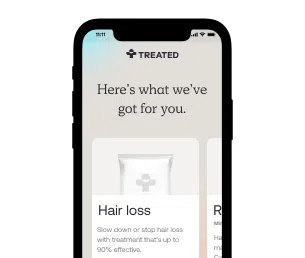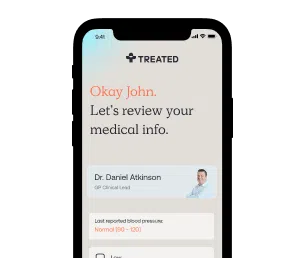Anaphylaxis
Fast-acting treatments for severe allergic reactions.
Secure delivery
UK clinicians
Anaphylaxis is a severe form of allergic reaction. In some instances it can be life-threatening, so having the right treatment is vital.
Answer a few questions about your health, and we’ll recommend medication tailored just for you. Order anaphylaxis treatment online, on subscription.
Anaphylaxis is a severe form of allergic reaction that can be life-threatening. An anaphylactic response happens when the body’s immune response system overreacts to the presence of a trigger substance and treats it as a threat to the body.
A trigger substance is anything that you are allergic to, such as nuts or penicillin. This trigger substance then releases a swell of chemicals, like histamine, which swells blood vessels in the body and restricts breathing.
Anaphylaxis happens to people who have severe allergies. Allergic reactions can vary from mild symptoms to life-threatening ones like anaphylactic shock. You never really know the severity of reaction you’ll have until you come into contact with the trigger substance. This is what can make allergic reactions so dangerous.
If you believe that you’re allergic to a certain substance, you should let our clinical team know. They can advise you on alternative treatments if a specific medication isn’t suitable for you.
Global prevalence data is difficult to get, but allergy and anaphylaxis prevalence is increasing year on year. It's believed that the figures could be rising for a couple of reasons. One reason could be that we are getting better at diagnosing allergies now that they are much more common than they used to be.
Another previously held theory was that children are growing up in a more sanitary environment than they used to; and because these children aren’t being exposed to as many germs or bacteria, their immune systems aren't working as they should. However there’s a growing consensus that this probably isn’t actually the case .

How we source info.
When we present you with stats, data, opinion or a consensus, we’ll tell you where this came from. And we’ll only present data as clinically reliable if it’s come from a reputable source, such as a state or government-funded health body, a peer-reviewed medical journal, or a recognised analytics or data body. Read more in our editorial policy.
Anaphylaxis is caused when the body’s immune system wrongly perceives a certain trigger to be a threat. This trigger then activates an antibody in your body called immunoglobulin E (IgE). It’s this antibody that causes a sudden rush of chemicals, including histamine. This sudden rush forces your blood vessels to swell and your breathing to become restricted. If medical attention is not sought immediately, it can cause heart failure and death.
Some of the more common triggers include foods such as nuts, fish and milk, but it can also be insect stings, certain medications or latex. Allergic reactions vary from person to person and some people aren't allergic to anything at all. Allergy tests can be requested through your clinician. These will test your body's reaction to common substances that people are allergic to.
Anaphylaxis can happen very suddenly when you come into contact with a trigger substance. Symptoms can often include:
If you notice any of these symptoms, you should call an ambulance immediately. Anaphylaxis can be life-threatening and requires emergency treatment.
Anaphylaxis is a problem in itself and is caused by a reaction to other problems, like your body wrongly perceiving something to be a threat. Due to the severity of its nature, it should be avoided wherever possible. It can be particularly stressful if you have an allergy to a common substance like nuts.
If you’re at risk of anaphylaxis, it’s very important that you carry your treatment with you at all times. You should also check that your treatment is in date and seek new treatment if it isn’t.

How we source info.
When we present you with stats, data, opinion or a consensus, we’ll tell you where this came from. And we’ll only present data as clinically reliable if it’s come from a reputable source, such as a state or government-funded health body, a peer-reviewed medical journal, or a recognised analytics or data body. Read more in our editorial policy.

How we source info.
When we present you with stats, data, opinion or a consensus, we’ll tell you where this came from. And we’ll only present data as clinically reliable if it’s come from a reputable source, such as a state or government-funded health body, a peer-reviewed medical journal, or a recognised analytics or data body. Read more in our editorial policy.
Have something specific you want to know? Search our info below, or ask our experts a question if you can’t find what you’re looking for.
Microbial exposures that establish immunoregulation are compatible with targeted hygiene. The Journal of Allergy and Clinical Immunology, 148(1), pp.33–39. [Accessed 17 Dec. 2021].
Studies in the Pathogenesis of Anaphylaxis. clinicaltrials.gov. [Accessed 11 Oct. 2021].
Adrenaline in the acute treatment of anaphylaxis. Deutsches Aerzteblatt Online, 115(31-32).

Registered with GMC (No. 4624794)
Meet Daniel
Registered with GPhC (No. 2202465)
Meet Sanjeda
Registered with GPhC (No. 2070724)
Meet Craig
Always read the leaflet that comes with your medication and tell us about any side effects you get.
We know health, but you know you.
Our experts tell you what’s safe, but you decide what’s best.
Answer a few questions and tell us about yourself. Get tailored advice from our clinicians so you can choose better.

Choose your treatment and how often you have it delivered.

We know things change. It’s the nature of life. We’ll check in regularly to make sure your treatment is still right for you.
Pause. Change. Skip. Start again. Any time you like.
Here are some other things we can help with.
Choose from our range of tablets and solutions. Get ongoing care and support from our experts.
Stop smoking treatments that can help you kick the habit forever, and reduce your risk of disease.
Tablets or injections. Tailored weight loss treatments combined with ongoing support from our experts.
We're making healthcare more about you. Sign up to our newsletter for personalised health articles that make a difference.
Disclaimer: The information provided on this page is not a substitute for professional medical advice, diagnosis, or treatment. If you have any questions or concerns about your health, please talk to a doctor.
We couldn't find what you're looking for.
Here's everything we treat. Or, if you're looking for something we don't have yet, you can suggest something.
If there’s a particular treatment or condition you’re looking for, tell us and we’ll look into it for you.
Submit your question here, or tell us if you’ve found an issue on our site.
We’ll get back to you very soon. We aim to respond to all queries in one working day.
You’re signed up to our newsletter. Keep an eye on your inbox for our latest update.
By clicking 'Subscribe now' you're agreeing to our Privacy Policy.
We’ve sent you an email asking you to confirm your email address.